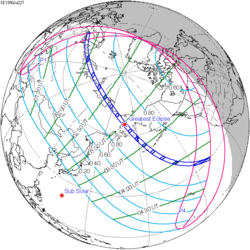| Annular eclipse | |
| Gamma | 1.0102 |
|---|---|
| Magnitude | 0.9497 |
| Maximum eclipse | |
| Duration | - |
| Coordinates | 61°00′S35°18′E / 61°S 35.3°E |
| Max. width of band | - km |
| Times (UTC) | |
| Greatest eclipse | 3:01:49 |
| References | |
| Saros | 154 (8 of 71) |
| Catalog # (SE5000) | 9604 |
An annular solar eclipse will occur at the Moon's descending node of orbit on Saturday, October 3, 2043, [1] with a magnitude of 0.9497. A solar eclipse occurs when the Moon passes between Earth and the Sun, thereby totally or partly obscuring the image of the Sun for a viewer on Earth. An annular solar eclipse occurs when the Moon's apparent diameter is smaller than the Sun's, blocking most of the Sun's light and causing the Sun to look like an annulus (ring). An annular eclipse appears as a partial eclipse over a region of the Earth thousands of kilometres wide. Occurring about 4.8 days before apogee (on October 7, 2043, at 23:20 UTC), the Moon's apparent diameter will be smaller. [2]
Contents
- Images
- Eclipse timing
- Places experiencing partial eclipse
- Eclipse details
- Eclipse season
- Related eclipses
- Eclipses in 2043
- Metonic
- Tzolkinex
- Half-Saros
- Tritos
- Solar Saros 154
- Inex
- Triad
- Solar eclipses of 2040–2043
- Saros 154
- Metonic series
- Tritos series
- Inex series
- References
- External links
It will be unusual in that while it is an annular solar eclipse, it is not a central solar eclipse. A non-central eclipse is one where the center-line of annularity does not intersect the surface of the Earth (when the gamma is between 0.9972 and 1.0260). Instead, the center line passes just above the Earth's surface. This rare type occurs when annularity is only visible at sunset or sunrise in a polar region.
While the path of annularity will be not visible from any land areas, a partial solar eclipse will be visible for parts of Madagascar, Antarctica, and southwestern Australia. This will be the first of 56 umbral eclipses in Solar Saros 154.























































































